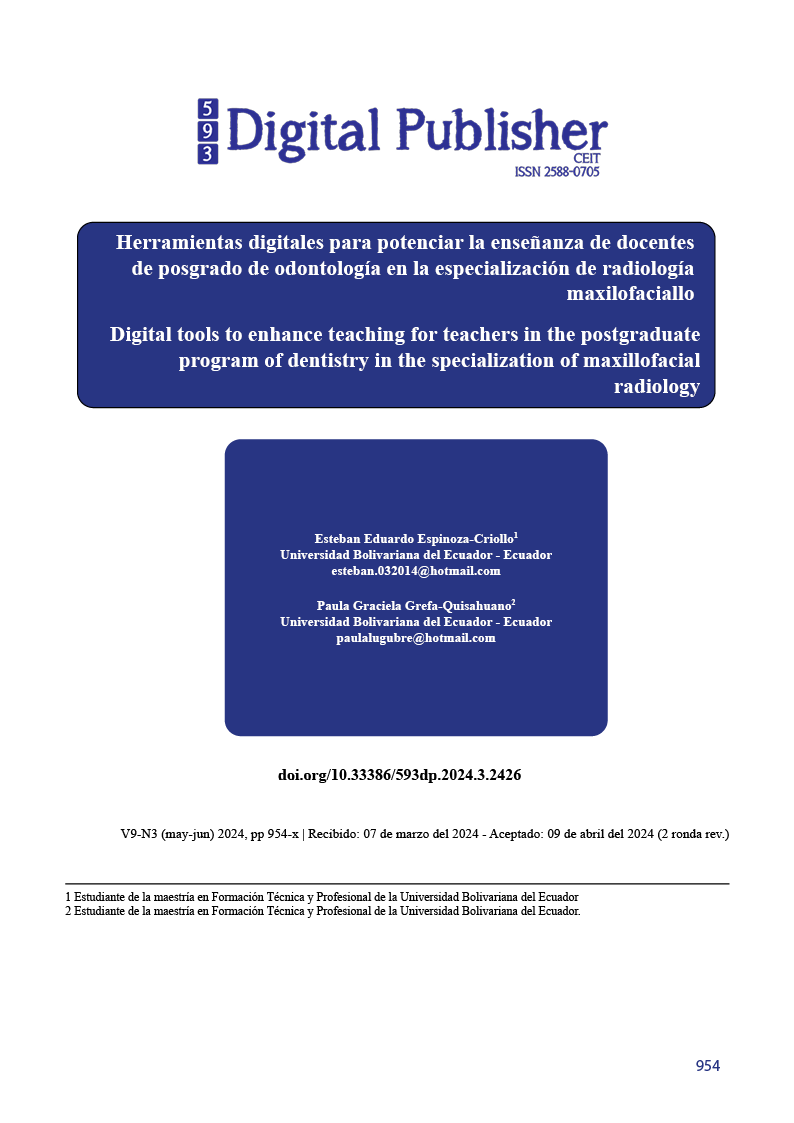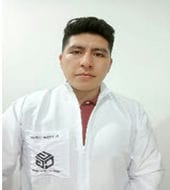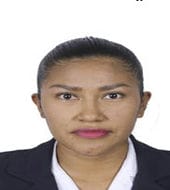Herramientas digitales para potenciar la enseñanza de docentes de posgrado de odontología en la especialización de radiología maxilofacial
Contenido principal del artículo
Resumen
En la universidad Hemisferios posgrado de odontología en la especialidad de radiología maxilofacial, ubicada en la ciudad de Quito, se ha podido observar que los docentes tras conocer las herramientas digitales educativas, no las utilizan de manera efectiva con los estudiantes, por lo cual el proceso de enseñanza aprendizaje se vuelve poco atractivo y tradicional, la misma que no proporciona una enseñanza interactiva y significativa en el proceso educativo.
Ante el panorama de surgimiento de nuevos paradigmas educativos como son: la inteligencia artificial (IA) y las tecnologías de la información y la comunicación (TIC), es fundamental incorporar cambios en los procesos de enseñanza -aprendizaje, de tal forma, que se alineen en la formación integral de los estudiantes.
Los docentes además de adquirir los conocimientos propios de sus áreas deberán alcanzar un nivel óptimo en competencias digitales, el uso de las TIC aplicadas en la educación originando aprendizajes colaborativos y significativos para lo cual se ha de enfatizar la importancia de impartir un plan de formación en alfabetización tecnológica dirigido a los docentes, considerando las actuales tendencias que facilitan acceso general del educando a las múltiples aplicaciones móviles, dispositivos y tabletas, entre otros. Por lo cual se considera necesario que los docentes manejen de forma apropiada las herramientas tecnológicas considerando los nuevos cambios y avances en la informática.
Descargas
Detalles del artículo

Esta obra está bajo una licencia internacional Creative Commons Atribución-NoComercial-CompartirIgual 4.0.
1. Derechos de autor
Las obras que se publican en 593 Digital Publisher CEIT están sujetas a los siguientes términos:
1.1. 593 Digital Publisher CEIT, conserva los derechos patrimoniales (copyright) de las obras publicadas, favorece y permite la reutilización de las mismas bajo la licencia Licencia Creative Commons 4.0 de Reconocimiento-NoComercial-CompartirIgual 4.0, por lo cual se pueden copiar, usar, difundir, transmitir y exponer públicamente, siempre que:
1.1.a. Se cite la autoría y fuente original de su publicación (revista, editorial, URL).
1.1.b. No se usen para fines comerciales u onerosos.
1.1.c. Se mencione la existencia y especificaciones de esta licencia de uso.
Citas
Inche, J. (2010). Modelo Dinámico de Gestión del Conocimiento basado en el
Aprendizaje Organizacional en una Institución Educativa en el Perú. [Tesis para
optar el grado de Doctor en Ciencias Administrativas]. UNMSM Unidad
de Posgrado. Chrome-extension://efaidnbmnnnibpcajpcglclefindmkaj https://cybertesis
.unmsm.edu.pe/bitstream/handle/20.500.12672/1139/Inche_mj.pdf?sequence=1
Kriscautzky, L. M. (2019). ¿Cómo y por qué nos formamos los docentes en el uso
de tecnología? Revista Digital Universitaria, 3 https://www.revista.unam.mx/2019v20n6/como-y-por-que-nos-formamos-los-docentes-en-el-uso-de-tecnologia/.
Visa, Mariona. (2014) El EEES como marco de desarrollo de las nuevas herramientas docentes
Amores, Antonio (2020) Las Nuevas Tecnologías como factor de motivación –
Cabero, J. y Romero, R., (2010). Diseño y Producción de TIC para la formación. Recuperado de
https://books.google.co.ve/books?isbn=849788163X
Fernández, E., Leiva, J. y López, E. (2017). Competencias digitales en docentes de Educación
Superior. Revista Digital de Investigación en Docencia Universitaria, 12(1), 213-231.
Recuperado de https://revistas.upc.edu.pe/index.php/docencia/article/view/558/752
Gómez, W. (2010). Significado que le dan los profesores al uso de las tics en los procesos de
enseñanza y de aprendizaje en dos instituciones educativas. Recuperado de
http://www.colombiaaprende.edu.co/html/docentes/
Araujo de Cendros, Dory; Bermudes, José Limitaciones de las tecnologías de información y
comunicación en la educación universitaria https://www.redalyc.org/pdf/979/97912444001.pdf
Echeverria, Viviana, Molina Paulina (2017) Herramientas digitales en el aprendizaje y su
relación con las habilidades creativas de los estudiantes.
https://revistas.itsup.edu.ec/index.php/sinapsis/article/view/608/1539
Valle, Y. (2018.) Sin las TIC, la educación superior y de posgrado no está completa
Belloch, C. (2015). Las Tecnologías de la Información y Comunicación en el aprendizaje.
Universidad de Valencia: Valencia, España. Recuperado de https://www.uv.es/bellochc/pedagogia/EVA1.pdf



